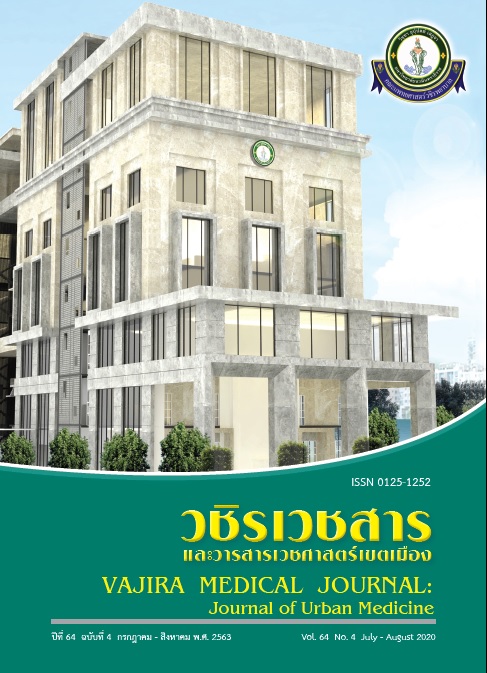Effects of I-Walk Training on Gait Performances in Patients with Chronic Stroke
Main Article Content
Abstract
Objective: To determine the effects of I-Walk (Robotic-assisted gait device) training compared with over-ground walking training on motor impairments assessed by lower extremity scores, lower extremity angles during walking, and gait performances in patients with chronic stroke.
Methods: A single blinded randomized controlled trial was conducted. Twenty four chronic stroke patients were randomly assigned into two groups; experimental group (n=12) and control group (n=12). For gait performances, patients in an experimental group received I-Walk training, while those in a control group received over-ground walking training. The duration of training was 60 min per day, 3 days per week for 8 weeks. The outcome measures included motor impairments assessed by the Fugl-Meyer Assessment of Lower Extremity (FMA-LE) scores, lower extremity angles during walking (hips, knees, ankles), and gait performances (step length, cadence, walking speed, stride length, and step length symmetry ratio). All variables were measured before and after the training period.
Results: There was a statistically significant difference in motor impairments assessed by the FMA LE scores, lower extremity angles during walking on hips and knees, as well as gait performances, including step length, cadence, and walking speed, between the experimental and the control groups (p<0.05). In particular, the statistically significant changes were demonstrated in motor impairments assessed by the FMA-LE scores, lower extremity angles during walking on hips, knees, and ankles, as well as gait performances, including step length, cadence, walking speed, stride length, and step length symmetry ratio, before and after the I-Walk training in the experimental group (p<0.05).
Conclusions: The I-Walking training could yield a statistically significant improvement of motor impairments assessed by FMA-LE scores, lower extremity angles during walking, and gait performances in chronic stroke patients. Nonetheless, further studies are recommended to elucidate and ratify the effective outcomes in patients with other stages of stroke, different ranges of lower extremity, and various spatiotemporal parameters.
Downloads
Article Details
References
Latham NK, Jette DU, Slavin M, Richards LG, Procino A, Smout RJ, et al. Physical therapy during stroke rehabilitation for people with different walking abilities. Arch Phys Med Rehabil 2005;86(12 Suppl 2):41-50.
Langhorne P, Coupar F, Pollock A. Motor recovery after stroke: A systematic review. Lancet Neurol 2009;8(8):741-54.
Ilunga Tshiswaka D, Bennett C, Franklin C. Effects of walking trainings on walking function among stroke survivors: A systematic review. Int J Rehabil Res 2018;41(1):1-13.
Pound P, Gompertz P, Ebrahim S. A patientcentred study of the consequences of stroke. Clin Rehabil 1998;12(4):338-47.
Mehrholz J, Pohl M. Treadmill training and body weight support for walking after stroke. Cochrane Database Syst Rev 2014(1):CD002840.
Mehrholz J, Pohl M. Electromechanical-assisted gait training after stroke: A systematic review comparing end-effector and exoskeleton devices. J Rehabil Med 2012;44(3):193-9.
Schwartz I, Sajin A, Fisher I, Neeb M, Shochina M, Katz-Leurer M, et al. The effectiveness of locomotor therapy using robotic-assisted gait training in subacute stroke patients: a randomized controlled trial. PM R. 2009;1(6):516-23.
Hesse S, Schattat N, Mehrholz J, Werner C. Evidence of end-effector based gait machines in gait rehabilitation after CNS lesion. NeuroRehabilitation 2013;33(1):77-84.
Neto VP, Rombaldi A, Saes M, Siqueira F. Physical activity and gait kinematics in the elderly. Braz J Phys Ther 2015;20(3):243-50.
Pramodhyakul N, Amatachaya P, Sooknuan T, Arayawichanon P, Amatachaya S. Effects of a visuotemporal cue on walking ability of independent ambulatory subjects with spinal cord injury as compared with healthy subjects. Spinal Cord 2014;52(3):220-4.
Sayeed T, Samà A, Català A, Cabestany J, editors. Comparison and adaptation of step length and gait speed estimators from single belt worn accelerometer positioned on lateral side of the body. Intelligent Signal Processing (WISP) IEEE 8th International Symposium; 2013 September 16-18; Funchal, Portugal: IEEE; 2013. 14-20.
Kirtley C. Clinical gait analysis: theory and practice. Edinburgh: Livingstone. 2006. 16-20.
Patterson KK, Gage WH, Brooks D, Black SE, McIlroy WE. Evaluation of gait symmetry after stroke: A comparison of current methods and recommendations for standardization. Gait Posture 2010;31(2):241-6.
Hesse S, Werner C, Uhlenbrock D, Frankenberg SV, Bardeleben A, Brandl-Hesse B. An electromechanical gait trainer for restoration of gait in hemiparetic stroke patients: Preliminary results. Neurorehabil Neural Repair 2001;15(1):39-50.
Ribeiro T, Britto H, Oliveira D, Silva E, Galvão E, Lindquist A. Effects of treadmill training with partial body weight support and the proprioceptive neuromuscular facilitation method on hemiparetic gait: a randomized controlled study. Eur J Phys Rehab Med.2013;49(4):451-61.
Hesse S, Werner C. Post stroke motor dysfunction and spasticity: novel pharmacological and physical treatment strategies. CNS Drugs.2003;17(15):1093-107.
Pollock A, Baer G, Pomeroy V, Langhorne P. Physiotherapy treatment approaches for the recovery of postural control and lower limb function following stroke. Cochrane Database Syst Rev 2007(1):249-62.
Hubbard IJ, Parsons MW, Neilson C, Carey LM. Task-specific training: Evidence and translation to clinical practice. Occup Ther Int 2009;16(3-4):175-89.
Klimecki OM, Leiberg S, Lamm C, Singer T. Functional neural plasticity and associated changes in positive affect after compassion training. Cereb Cortex 2013;23(7):1552-61.
Damiano DL, Norman T, Stanley CJ, Park H-S. Comparison of elliptical training, stationary cycling, treadmill walking and overground walking. Gait Posture 2011;34(2):260-4.
Woolley SM. Characteristics of gait in hemiplegia. Top Stroke Rehabil 2001;7(4):1-18.
Forrester LW, Roy A, Krebs HI, Macko RF. Ankle training with a robotic device improves hemiparetic gait after a stroke. Neurorehabil Neural Repair. 2011;25(4):369-77.
Salbach NM, Mayo NE, Higgins J, Ahmed S, Finch LE, Richards CL. Responsiveness and predictability of gait speed and other disability measures in acute stroke. Arch Phys Med Rehabil 2001;82(9):1204-12.
Fulk G, L Echternach J. Test-retest reliability and minimal detectable change of gait speed in individuals undergoing rehabilitation after stroke. J Neurol Phys Ther 2008;32(1):8-13.


